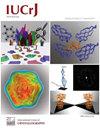Using multiple computer-predicted structures as molecular replacement models: application to the antiviral mini-protein LCB2
IF 3.6
2区 材料科学
Q2 CHEMISTRY, MULTIDISCIPLINARY
引用次数: 0
Abstract
A set of crystallographic structures has been obtained for the small antiviral protein LCB2 using molecular replacement models from six different structure-prediction programs. This set of structures can be interpreted as a multiconformer ensemble, improving quality metrics and offering an interesting insight into side-chain dynamics.
In this report, we describe a set of structures of the engineered protein LCB2 that has been solved starting from different computer-predicted molecular replacement (MR) models. We found that AlphaFold3, AlphaFold2, MultiFOLD, Rosetta, RoseTTAFold and trRosetta all produced successful MR models for this three-helix bundle 58-residue protein, while some of the older predictors failed. To assign B factors in the MR models we used the predictor-generated confidence scores or, as a convenient alternative, the accessible surface area (ASA) values. The process of multi-start structure determination using Coot and Phenix demonstrated good convergence, leading to six structures within 0.25 Å (all-atom RMSD) of each other. Of note, structural differences between the computer-predicted MR models and the final structures can be largely attributed to a single specific crystal contact. Comparing the six structural solutions, we observe that a number of surface side chains have been solved with different conformations. Interestingly, for each individual structure the electron density is consistent with a single rotameric state and offers no direct evidence of conformational heterogeneity. Strictly speaking, this behavior constitutes a case of model bias; we argue, however, that it represents a benign side of model bias. Specifically, when we use a model where the side-chain conformation corresponds to one of the actual (significantly populated) rotameric states, this leads to an enhancement of the electron density for this particular conformation. Conversely, when we use a model with an irrelevant (low-population) side-chain conformation, it fails to produce the matching electron density. We thus conclude that the six LCB2 structures obtained in this study can be grouped into a multiconformer ensemble, where structural variations are representative of protein’s conformational dynamics. Indeed, using this six-member ensemble leads to a significant drop in Rwork and Rfree compared with the individual solutions. This interpretation was also supported by our MD simulations of the LCB2 crystal.
用多种计算机预测结构作为分子替代模型:在抗病毒小蛋白LCB2中的应用。
在本报告中,我们描述了一组工程蛋白LCB2的结构,这些结构已经从不同的计算机预测分子替代(MR)模型开始解决。我们发现AlphaFold3、AlphaFold2、MultiFOLD、Rosetta、rosettold和trRosetta都能成功地对这种三螺旋束58-残基蛋白产生MR模型,而一些较老的预测器则失败了。为了在MR模型中分配B因子,我们使用了预测器生成的置信度分数,或者作为方便的替代方法,可达表面积(ASA)值。使用Coot和Phenix进行多起始结构确定的过程具有良好的收敛性,在0.25 Å(全原子RMSD)范围内得到6个结构。值得注意的是,计算机预测的MR模型和最终结构之间的结构差异可以在很大程度上归因于单个特定的晶体接触。比较六种结构解,我们观察到许多表面侧链已被求解成不同的构象。有趣的是,对于每个单独的结构,电子密度与单一的旋美态一致,没有提供构象异质性的直接证据。严格地说,这种行为构成了模型偏差;然而,我们认为,它代表了模型偏差的良性一面。具体来说,当我们使用一个模型,其中侧链构象对应于一个实际的(显著填充的)旋美态时,这导致了这种特殊构象的电子密度的增强。相反,当我们使用不相关(低人口)侧链构象的模型时,它无法产生匹配的电子密度。因此,我们得出结论,本研究中获得的六个LCB2结构可以归为一个多构象集合,其中结构变化代表了蛋白质的构象动力学。实际上,与单独的解决方案相比,使用这个六成员集合会导致Rwork和Rfree的显著下降。我们对LCB2晶体的MD模拟也支持了这一解释。
本文章由计算机程序翻译,如有差异,请以英文原文为准。
求助全文
约1分钟内获得全文
求助全文
来源期刊

IUCrJ
CHEMISTRY, MULTIDISCIPLINARYCRYSTALLOGRAPH-CRYSTALLOGRAPHY
CiteScore
7.50
自引率
5.10%
发文量
95
审稿时长
10 weeks
期刊介绍:
IUCrJ is a new fully open-access peer-reviewed journal from the International Union of Crystallography (IUCr).
The journal will publish high-profile articles on all aspects of the sciences and technologies supported by the IUCr via its commissions, including emerging fields where structural results underpin the science reported in the article. Our aim is to make IUCrJ the natural home for high-quality structural science results. Chemists, biologists, physicists and material scientists will be actively encouraged to report their structural studies in IUCrJ.
 求助内容:
求助内容: 应助结果提醒方式:
应助结果提醒方式:


